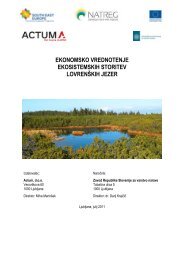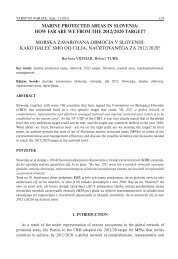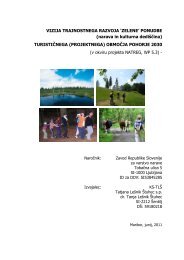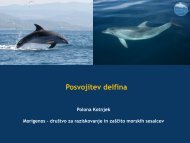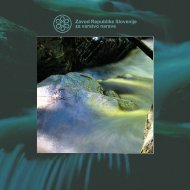Monitoring MPA visitor uses handbook
Monitoring MPA visitor uses handbook
Monitoring MPA visitor uses handbook
- No tags were found...
You also want an ePaper? Increase the reach of your titles
YUMPU automatically turns print PDFs into web optimized ePapers that Google loves.
5. IndicatorsBased on the requirements defined by the manager, the indicators may be implemented separately or in connectionwith other indicators. An indicator may be used on a one-off basis or reproduced to monitor variations in <strong>visitor</strong> use.5.1 Water and waste indicator5.1.1 RelevanceIndirect evaluation of <strong>visitor</strong> use and consumptionbehaviourWater and waste management is a key component ofproblems inherent in coastal and island tourism in <strong>MPA</strong>s.This indicator provides data on :• The amount of water consumed in the <strong>MPA</strong>; it alsomonitors the ratio between water consumption andthe status of the resource.• The volume of wastewater treated in plants, mainlygenerated by domestic and tourist <strong>uses</strong> in coastal andisland areas.• Quantities of waste collected in the <strong>MPA</strong>.• This indicator also provides information about <strong>MPA</strong>user behaviour with respect to the environment andconsumption modes (water saving principles, purchasingof packaged products, etc.).Collection method : Manual collection of macro-wasteand measurement of the volume and types of macrowasteusing calibrated containers (dustbin bags forexample).Frequency : Daily on a small beach representative of the<strong>MPA</strong> to evaluate the annual or summer season volume.If the collection concerns the entire <strong>MPA</strong>, a collectioncampaign provides an order of magnitude of the amountof macro-waste. Five campaigns during a summer arenecessary to assess variations between summer seasons.Time and cost : For a small representative beach, dailycollection can be combined with a site surveillance patrol.Large-scale waste collection campaigns are morelabour-consuming. Volunteers may be involved andcampaigns can thus be integrated into public awarenessactions.Archiving : Excel©-type spreadsheet.5.1.2 Relevant <strong>MPA</strong> typesContinentor island<strong>MPA</strong>Continentor island<strong>MPA</strong>5.1.3 Framework protocolsa/ Existing data collectionData collected : Monthly volumes of water consumedand treated, monthly tonnage of waste collected.Collection method : Collection of pre-processed datafrom entities responsible for water supply, water treatmentand waste collection. This method requires a partnershipwith these organisations to ensure continuousdata transmission.Frequency : Contact with organisations once a year.Time and cost : one day of work by one person tocontact the organisations and archive the data.Archiving : Excel©-type spreadsheet.b/ Evaluation of macro-waste quantities onbeachesMacro-waste collection by hand, Zakynthos National Park (Greece).© Credit: Jean-Pierre de Palma5.1.4 AdviceWhen archiving the data, specify any unusual event thatmay significantly affect volumes of water or the wastetonnage during the year, such as system leakages, a fire,construction work, a container running aground, etc.This indicator does not lead to a precise evaluation ofthe extent of <strong>visitor</strong> use, but allows the main trends tobe assessed. It can be combined with indicators thatdirectly quantify <strong>visitor</strong> use to obtain information aboutuser consumption patterns.The amount of waste measured on a beach is not solelygenerated by the people visiting the site. Waste can alsocome from more distant areas and be carried by thesea's currents.This protocol is relevant if beach waste management is amajor problem for the manager and no data is availableto quantify the waste.Data collected : Volumes of macro-waste collected. TABLE OF CONTENTS 18 COLLECTION VISITOR USE OBSERVATION AND MONITORING IN MEDITERRANEAN MARINE PROTECTED AREAS



